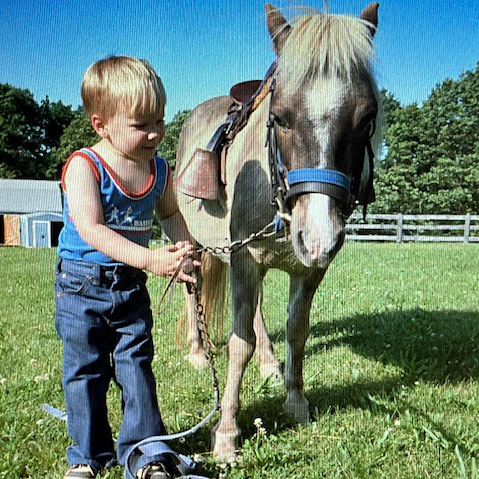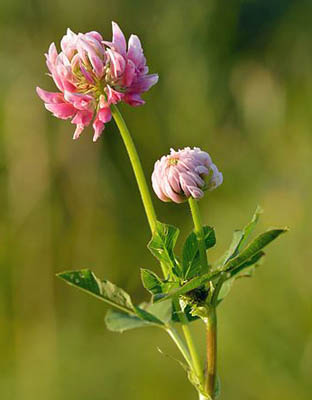So, You Think You Love Horses?
Some Reflections on the Nature of Horses and Man
Glossary of Equestrian Terms
Words Beginning with A
-
Above the Bit
[Basic Riding] A rider always wishes to be what is called "on the bit." This is maintaining proper contact pressure with the reins and bit so as to effectively use the bit as an aid in communicating the rider's intentions to the horse. When a horse gets above the bit it has raised his head up and has broken this contact. The rider then has lost any leverage on the horse's mouth. This might be an unintended consequence of a stumble or break in stride that caused the horse to throw its head upwards or it might be willful misbehavior on the part of the horse. When a horse gets above the bit during a canter you often experience a sudden acceleration and the challenge is to get the horse back on the bit without overreacting to it and maybe precipitating bucking. The opposite of being above the bit is called being behind the bit.
-
Acceptance
[Basic Riding] Acceptance on the part of a horse is its ability to willingly receive cues from the rider without any kind of resistance or protest. At the heart of acceptance is the horse's trust in the leadership of the rider. It is a bond that is created over time and should never be taken lightly. A rider should acknowledge and appreciate the acceptance of his mount.
-
Account for
[Fox Chasing] Historically this term was understood to indicate a fox that had been either killed or put to ground (forced to take shelter in a hole) by the hounds. In former times terriers were employed to root the fox out. Current practice does not allow that.
-
Acepromazine (ACE)
[Veterinary Medicine] Acepromazine is a phenothiazine-derived psychotropic drug that in low doses is used as a calming agent in excited horses. If too much is given, it can cause a horse to be mildly wobbly and uncoordinated. Its use in stations is not recommended as it can cause permanent erection (priapism) or penile paralysis (paraphymosis), both of which are very serious and not easily treated.
-
Acey-Deucy
[Horse Racing] An adjustment to the pair of stirrups such that the inside one is lower that outside one. This allows better balance while taking a turn at speed.
-
Action
[Equine Movement] A horses action is their particular style of movement, the way they move their legs. An attractive action has good confirmation and conditioning as its foundation. All of the various joints of the equine body contribute, but an animated elevation of the leg and bending of the knee are a major determinate. Watching gaited horses in the show ring or dressage horses doing a test is a good way to compare the actions of similar horses. Movement should flow smoothly between gaits, but at the same time be emphatic. A spectator should not be passively watching, but should be educating their eyes to appreciate the action they are observing.
-
Acupuncture in Horses
Acupuncture Needles Placed in the Back
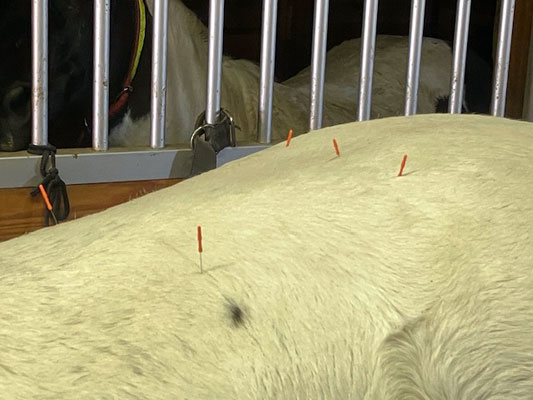
|
[Veterinary Medicine ] Acupuncture is fairly well-accepted as a form of complimentary medicine in horse care. The evidence basis for its use is somewhat clouded by the fact that the acupoints used by many practitioners are based on the human acupuncture system transposed onto animals. This transposition is not a uniform one and any given practitioner may use one of several given formats for acupoints. It can also be difficult to decide if a perceived response if a result of treatment or just a natural resolution. A horse cannot tell you about its experience. Science does not value testimonials, but for what it is worth, I have observed a treatment and the horse's body language indicated relaxation after the treatment. Being a sceptic about all things, I need to ask, did it help or was the animal just responding to people leaving it alone? To my eyes it seemed to work.
-
Add a Stride
[Jumping] In jumping competitions the rider may add a stride to the previous one when moving between two jumps, The effect is to shorten the stride length and be in a better position to take the jump. The opposite from adding a stride is referred to as leaving out a stride.
-
Adult Amateur
[Horse Showing] Horse shows have various categories in an effort to provide even competition. An adult amateur category is open to amateur riders over the age of 18.
-
African Horse Sickness (AHS)
[Veterinary Medicine] African horse sickness is a life-threatening hemorrhagic disease of horses sped by midges, mainly in sub-Saharan Africa, and caused by the double-stranded RNA African horse sckness virus of the Orbivirus genus.
-
Agility Activities with Horses
[Equine Activity] Horses can do agility work and competitions similar to dogs. These might be done on leads or with the horse free, but in all cases the human is on the ground. The point is the training and human-horse bond rather than just "doing tricks." The horse might jump jumps, jump through hoops, navigate an obstacle course, etc.
-
Agripin
An Agripin on a Stirrup
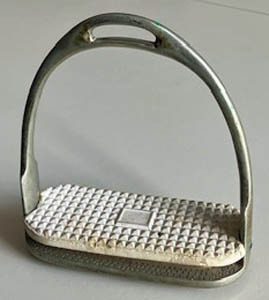
|
[Equestrian Equipage] Agripins are hard plastic inserts that clip into slots on the bottom of stirrups to keep boots from slipping out of them.
Aids
[Basic Riding] An aid is any measure that allows a rider to signal intention to the horse. Those may be natural ones, such as leg pressure, the human voice or shifts of weight in the saddle or artificial ones, such as exerting pressure on the mouth with the bit or taping with a riding crop. Schooling a horse is done with the intention of reinforcing a consistent and timely response of the animal to the rider's use of various aids.
-
Air
{Equine Motion] A horse's airs describe the manner, rhythm and bearing of its gaits.
-
Airs Above the Ground
[Classical Dressage] A demonstration exercise in which the horse is momentarily suspended in the air with at least two feet off the ground. The forms include: the levade, courbette and capriole. These can be witnessed at dressage exhibitions of the Spanish Riding School of Vienna and required extensive training and strength.
-
Akhal-Teke
Akhal-Teke
(Courtesy: Artur Baboev via Wikipedia)
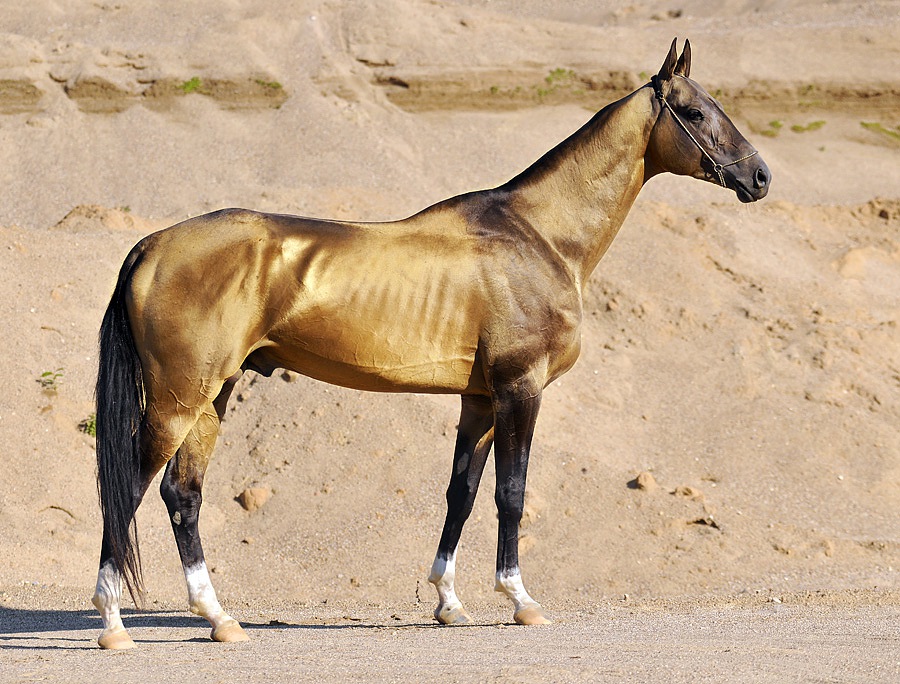
|
[Horse Breed] Akhal-Tekes are a distinctive breed of horse, native to Turkmenistan. They are considered to have speed, endurance, intelligence, and a distinctive metallic sheen to their coats. Modern Akhal-Tekes likely have some Thoroughbred antecedents, introduced in a Russian effort to produce even more speed. However, it may be also true that the imported oriental stallions who were the foundation of the Thoroughbred bloodlines and are generally considered to have been Arabians, may have had had some Turkmen blood as well. The breed was originally produced as a prized mount used in raiding by the Teke Turkmen tribe at the oasis of Akhal. Once the tribe in modern times was forced to abandon their lawless ways, these horses became distinctly rare.
-
Alfalfa
[Equine Fodder] Alfalfa is a nutrient rich leguminous plant with clover-like leaves and bluish flowers grown for fodder. It is often baled with grass hay. It should be used with caution because of its rich nature that can cause laminitis and founder, developmental orthopedic disease in young horses, calcium-phosphorus imbalance, obesity and insulin resistance and heat stress when fed large amounts in warm climates.
-
All King Edward's Horses Can Make Big Fences
[Dressage Mnemonic] When moving clockwise around an America dressage ring, the mnemonic "All King Edward's Horses Can Make Big Fences" reflects the order of the lettered signs: A, K, E, H, C, M, B and F.
-
All On
[Fox Chasing] The hounds are said to be "All on" when all are present and accounted for. It happens that in the course of a hunt individual hounds, who are valuable animals, become separate from the pack and are unaccounted for. It is always a relief when they are "All on."
-
Alligator
[Cutting] A term for a cow that resists being cut out and repeatedly returns to the herd.
-
Alsike Clover (Trifolium hybridum)
[Plant Toxic to Horses] Alsike clover may appear similar to other clovers but has a distinctive pinkish flower. The upper parts of the flower are fairly white and the lower pink. It is toxic to horses, causing a photosensitivity reaction of skin and less commonly liver failure. Ordinary red and white clovers present little issues for horses.
-
Also Ran
[Horse Racing] A race horse that did not finish either first, second or third in a race.
-
Amble
[Equestrian Gaits] A amble is a generic term applied to range of four-beat, intermediate speed horse gaits that are seen in different breeds of horses and are approximately the speed of a trot or pace but far smoother to ride. Often there are more specific names given to ambling gaits of the specific breed. The gaits are considered to be fatiguing to the horse over a long distance.
-
American Albino (American White and American Creme)
[Horse Color Type] Horses that were termed American Albinos were not true genetic albinos, but had a white coat similar to true albino animals. A registry had existed for them prior to the name being changed to American White and American Creme registry, reflecting the fact the horses are not true albinos. They are born white unlike horses with a gray coat color who become white over time. White horses are subject to skin damage by ultra-violet light and are best served being indoors during peak sun exposure. The situation with cremes is similar with their color more creme than white. Horses named for a coat color may have various background breeds, such as Arabians.
-
American Buckskin
[Horse Color Type] Horses eligible for registration as American buckskin, include those with a buckskin, dun, red dun, grulla (mouse dun), dunalino or perlino coat color Horses named for a coat color may have various background breeds, even mules.
-
American Cream Draft
[Equine Breed] American Cream Draft Horse is a rare breed of draft horse that originated in the United States. Their coat has a cream color with pink skin, amber eyes and a white mane and tail. They have attributes similar to other draft breeds, but are not huge animals with geldings 16–16.3 hands high and mares 15-16 hands.
-
American Endurance Ride Conference (AERC)
[Equestrian Organization] The AERC is the governing organization for competitive endurance riding in the United States, located in Auburn, California, with a mission of promoting the sport of endurance riding and encouraging and enforcing the safe use of horses that are demonstrating their endurance abilities in a natural setting via the development, use and preservation of trails.
-
American Paint
American Paint
(Courtesy: Karakal via Wikipedia)
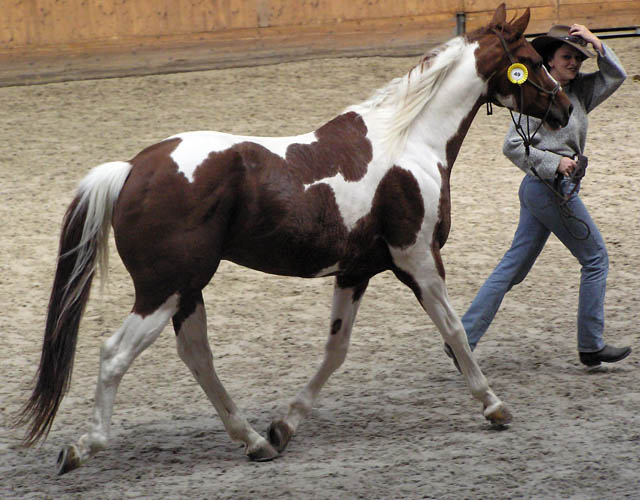
|
[Horse Breed] The American Paint Horse is a breed native to the United States. There distinctive feature is pinto coloration in which the coat combines of white with another color. When the American Quarter Horse Association prescribed standards, they excluded pintos. This guaranteed pinto owners would band together and create their own registry and eventually the American Paint Horse Association. No one can deny that in a group of horses the paints standout. They are mainly used in the various western riding disciplines with Quarter Horses, being the most important foundation of the breed. Should registered paints produce a solid colored offspring, it is eligible to be registered in a solid Paint-bred category. Each pattern of coloration has a specific name. Appaloosas not eligible since they are distinct and have their own registry.
-
American Saddlebred see Saddlebred
-
American White (see above)
-
Andalusian
[Equine Breed] Andalusian were originally developed in Spain and are a very ancient and elegant warm blood horse bred as a war horse and prized by the nobility, They have long manes and tails and are generally but not always grays, Their gaits are energetic and the breed is popular as dressage and as show horses. Other breeds, such as the Lipizzaners were developed from them.
-
Anestrus
[Equine Reproductive Cycle] That part of the estrous cycle in which a mare is not sexually reactive is termed being in the anestrus phase. This is the result of a lack of ovarian progesterone production.
-
Anglo-
[Equine Crossbreed] There are a number of crossbreed types described by adding a prefix Anglo to the name. The word Anglo indicates English and a member of the Thoroughbred breed that originated in England. The second part of the name is the other breed that it is crossed with.
-
Anglo-Arab
[Equine Crossbreed] An Anglo-Arab is a crossbred horse produced by crossing horses with Thoroughbred and Arab bloodlines,
Anglo-Arabs combine the attributes of the two contributing bloodlines. The Arabs contribute superior endurance and an even temperament. The Thoroughbreds add extra height and speed. They make excellent sport horses.
-
Anhidrosis
[Veterinary Medicine] Anhidrosis is a loss of or decreased ability to sweat normally. A horse having this condition has difficulty cooling itself after exercise or in a hot environment. It can lead to heat stroke and even death. Horses having this condition have an increased respiratory rate, panting, elevated temperature and appear distressed. Their coat is dry to the touch. The condition can be improved by putting them in the shade, sponging them with cool water and placing them under fans or in a breezy area. The condition is rare and may have a genetic basis, but is found in many different breeds. A horse known to have this condition must be managed with care.
-
Ankle Boots
[Equine Equipage] Ankle boots can be placed over the hind fetlock joints, typically to protect them from injury to the hind legs from interference, which is when the hoof of the foreleg hits the hindleg during some phase of a horse’s stride, also called brushing. Boots are made of leather, neoprene, PVC, often with gel or other padding and attach with straps or Velcro.
-
Appaloosa
[Equine Breed]
Appaloosas were originally bred by Native Americans of the Nez Perce Tribe in the western United States. Appaloosas are defined by their spotted coat colors, which is often mottled blue on gray. They also have a distinctive white sclera visible around the iris of the eyes. No matter what the color pattern of a particular animal is you can tell an Appaloosa by a mottled pattern of coloration on their far back and their striped hooves. The conformation and basic build of Appaloosas is more variable than many other breeds, as native peoples were often happy to get any horse that came their way and introduce it into their breeding stock. The breed fell into decline in the late 19th century when the Army deliberately destroyed Native American herds. However, the breed, much as the buffalo, has recovered and is now extremely popular.
-
Arabian Horse
Arab in Profile on a Polish Stamp and Ridden in Costume
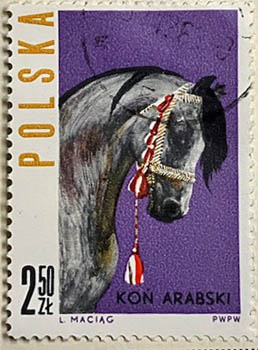
|
| 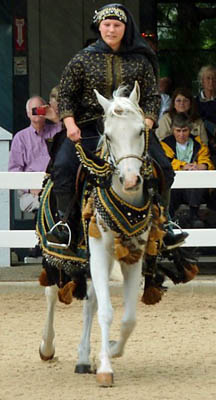
|
[Equine Breed] Arabs are a distinct breed that originated on the Arabian peninsula. Over centuries the breed was refined and acquired distinctive characteristics. Arabs are relatively small, easy keepers and known for their superior stamina. They have delicately formed heads with a prominent dish (depression) to the nose and relatively prominent and expressive eyes. They are intelligent and nimble. Perhaps the oddest thing about them is that they have one less lumbar spinal segment other horse breeds, that is only 5 lumber vertebrae, and thus are short coupled. This trait may allow a smaller animal to carry more weight. Their tail is carried high. All is all they are highly attractive animals that are useful in many types of riding.
-
Ardennals Horse (Ardennes Horse)
[Equine Breed] Ardennals horses are a heavily-built draft breed native to Ardennes region in the border lands of Belgium, Luxembourg, and France.
-
Ascending Oxer
[Show Jumping] A type of show jump construction in which two jump supports and poles are positioned in ascending order.
-
At Liberty
[Equine Activity] A horse that is free and unencumbered by a bridle or lead.
-
Automatic Release (Out of Hand Release)
[Equine Jumping] The automatic release is a jumping technique in which the rider's hands move alongside the horse's neck maintaining slight pressure from the reins on the bit, but not jerking the horses mouth with the bit or trying to balance using the reins (things you should not doing in any case). It requires a strong, well-coordinated rider with a absolutely secure seat. For other common release technique is called the crest release in which the rider lets the reins go somewhat slack and holds on to the mane during the jump. In both techniques the goal is to momentarily break firm contact with the mouth when the horse is extending its neck to jump. This is why the word release is used. It is a matter of timing and preserving contact and control when the jump is completed.
-
Autre Que Pur-Sang Horse (AQPS or French Chaser)
[Horse Breed] Autre Que Pur-Sang horses are French sport horses commonly used in the French form of steeplechase racing. The name translated as "other than pure blood." This breed was originally established as a military horse using "Pur-Sang" Thoroughbred stallions crossed with French mares of various breeding. If a horse is 100% Thoroughbred, well then you have a Thoroughbred and are not allowed to register it as a AQPS. That is logical if you think about it, but it makes for a strange situation in which a horse is defined by what it is not, rather than what it is.
-
Ayrag (Airag or Kumis -Turkic name)
[Horse Product] Ayrag is the Mongolian word for fermented mare's milk. Ayrag is highly nutritious and can be made into cheese and stored for a long time. It was so important to the diet of the steppe peoples that horses were selectively bred for being high milk producers.
Glossary of Equestrian Terms: Main Alphabetical Listing
Links to Other Sites with Equestrian Interests
Back to Introduction
